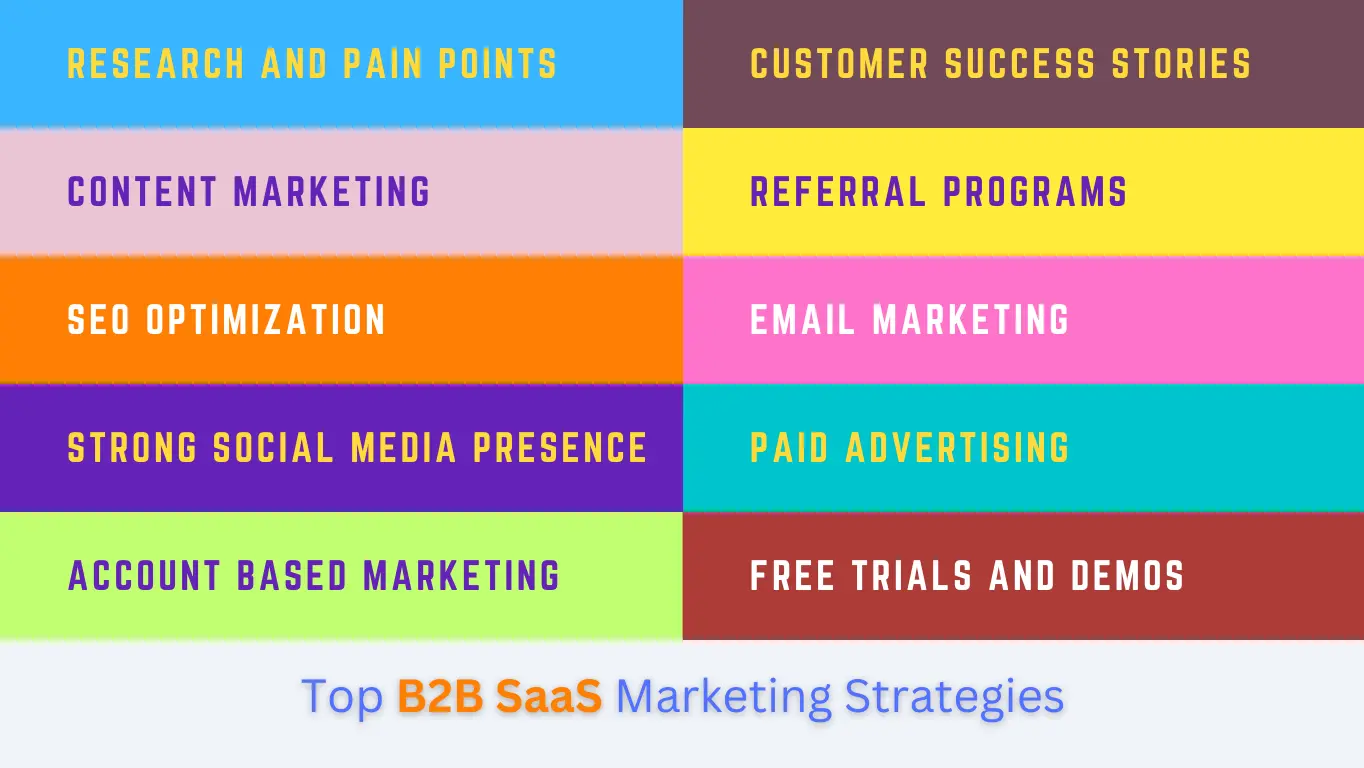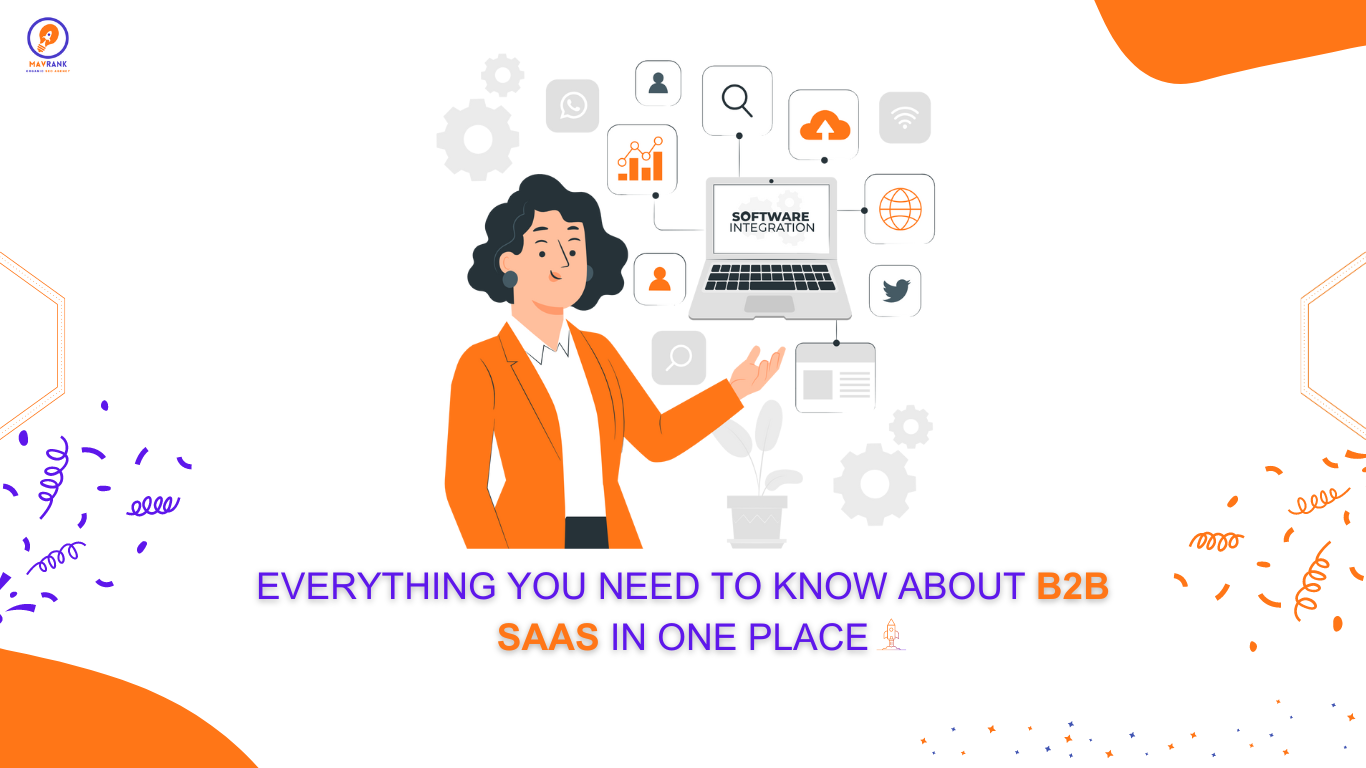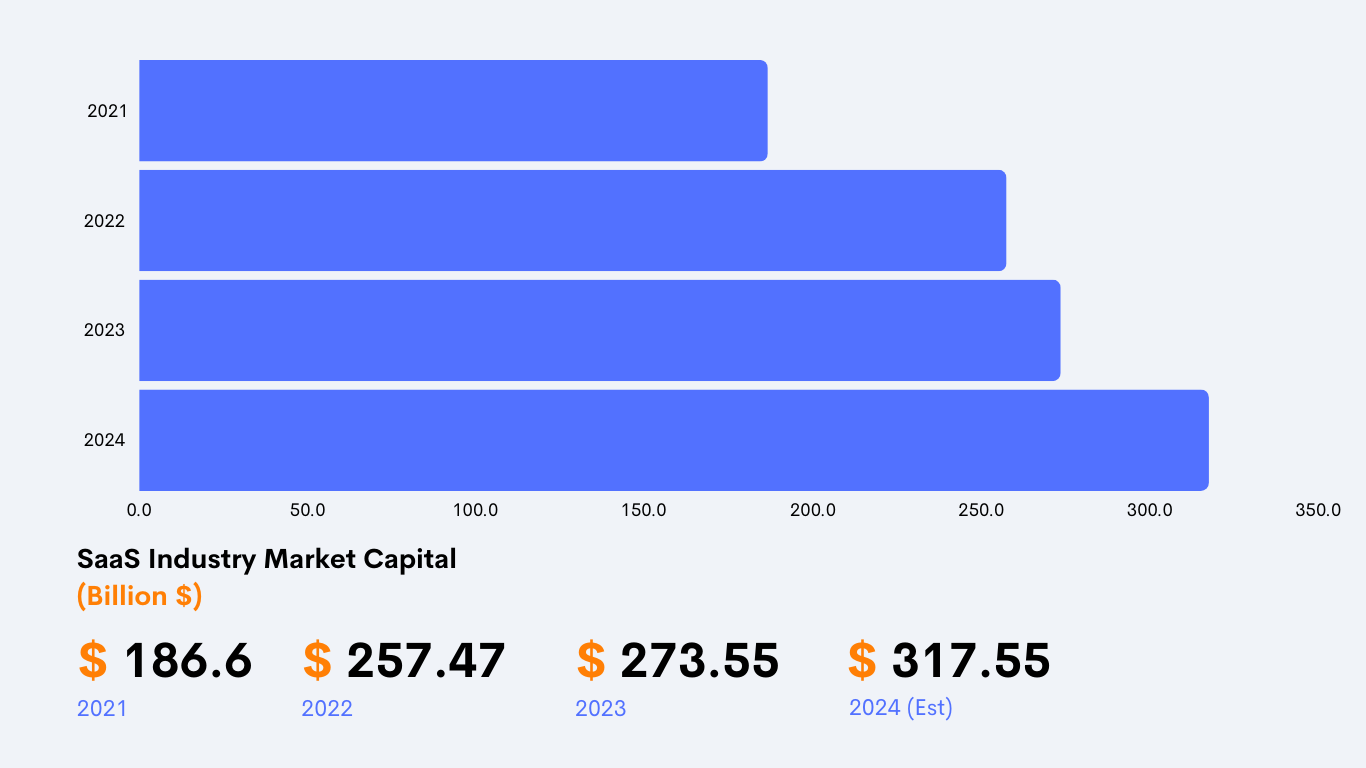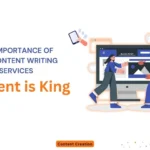This blog is meant to cover everything you need as a beginner. First, we’ll explain what it means, identify its advantages, and provide examples of SaaS companies taking advantage of it. Then, we’ll analyze how it is beneficial for businesses and detail its marketing strategies. Finally, we’ll see why it has become so important in the transition to digital business globally.
What is B2B SaaS?
B2B SaaS means Business-to-Business Software as a Service. It is a type of cloud-based software solution that a provider supplies to businesses on a subscription basis. These businesses can access and utilize the software through the Internet.
It is a cloud-based delivery model that enables organizations to deploy a program/software application over networks, especially via subscriptions, to improve operational efficiency.
This model enables businesses to automate processes, make their operations more efficient, and lower the costs that were previously associated with software ownership. B2B SaaS solutions are subscription-based providing flexibility and scalability to businesses to supplement the changing operational requirements.
How B2B SaaS differs from traditional software
There are two ways of providing solutions to business, SaaS B2B and traditional software.
A Provision of Service Software(SaaS) is a cloud-based system that provides businesses access to software remotely through the Internet. It also provides a subscription-based strategy. This model reduces hefty upfront costs and facilitates scale-up. On-site installation and maintenance are not required because they are the responsibility of the service providers. The B2B SaaS model provides flexibility because it can be assessed from any device with an Internet connection. The provider maintains updates to ensure users have the latest versions without extra effort.
However, the traditional software is installed directly on the hardware. This model requires an up-front investment into licensing or infrastructure setup as well as further expenses for maintenance and upgrades. Users have more control over the data and configuration of the software, but this also creates a new responsibility of ensuring security compliance. It can be used in situations where there is no outside connection and can provide better security, as the data is stored on the user’s computer.
Key Features of B2B SaaS Solutions:
SaaS solutions are characterized by several key features that distinguish it from traditional software solutions:
Subscription-Based Model:
The B2B SaaS software is provided on a subscription base with the businesses paying the monthly or yearly fee to use the software. It enables companies to be able to pay for software over a schedule rather than make at once a lump-sum investment. This enables SaaS vendors to have a steady revenue stream and corporations to expand or shrink their utilization depending on the demands.
Cloud Delivery:
B2B software is available as a cloud service which entails that user can assess the program online and it is hosted in the cloud. This means that companies do not have to set up and maintain software on individual computers. This also makes them more convenient to use and maintain, which is beneficial for especially geographically distant teams.
Scalability:
The scalability of the B2B SaaS products depends on the size of the business and can be easily scaled up or down in response to the changing needs of the company. This means companies can start with the most basic plan, and progress to more advanced features and user expandability as the business expands.
Accessibility:
Users can log in to the B2B SaaS solution from anywhere with an internet connection, usually on a desktop, laptop, tablet, or smartphone. It is very convenient for the remote team members.
Automatic Updates:
B2B SaaS applications are auto-updated with new functions and bug fixes. This means that the companies are always using the up-to-date version of the software without any additional effort or price, simply by being online.
Data Security and Compliance:
Reliable SaaS providers typically go the extra mile and provide airtight security features along with compliance with the mandated regulations. These may provide tremendous benefits to your business. It consists of services like encryption, access controls, regular security audits, and many others.
Integration Capabilities:
The majority of B2B SaaS applications integrate with other business applications like CRM systems, ERP systems, marketing automation platforms, etc. This facilitates uniformity of data and ultimately automation of workflows. It integrates a technology ecosystem.
Cloud-based SaaS applications have the biggest advantage over on-site program software, which is why many companies, big and small, like them very much. Such functions are turning out to be essential components of the B2B solution that businesses are embracing to streamline their operations, cut down costs, and still outcompete their rivals in cyberspace.
B2B SaaS companies:
Following are some prominent companies.
Salesforce:
It is a domineering figure in the landscape of B2B SaaS CRM( customer relationship management). Salesforce, a pioneer in SaaS, offers an all-in-one platform powered by artificial intelligence and analytics where sales, service, marketing, and commerce all are supported.
This essentially allows you to cultivate stronger relationships, improve efficiency, and in the end, optimize your profitability. Its subscription-based model leads to reduced upfront costs, flexibility in scaling, and remote access to the solution.
Adobe:
Adobe now serves as a major SaaS player in addition to its well-known former reputation of creative software. Their key proposition is Adobe Experience Cloud, which is a cloud-based platform that creatively addresses the marketing needs of all types of businesses. It offers marketing automation applications, data analytics dashboard, and customer experience management solutions. It enables businesses to create personalized marketing campaigns based on consumer behavior and improve the interaction process to enhance engagement.
Furthermore, Adobe Document Cloud is an essential tool for securing document management, e-signatures, and file sharing. The SaaS model enables Adobe to make business more flexible, scalable, and up-to-date through the most powerful features and this, certainly, makes it one of the major players in the SaaS business.
Slack:
Slack has achieved a status of absolute power in the world of B2B SaaS, introducing a new level of productivity and collaboration into the business environment. Its user-friendly interface gives a hand to users in establishing communication between channels, direct messaging, and file sharing.
A distinguishing factor to Slack’s success is how it enables thousands of app integrations with other third-party apps and tools. This enables the teams to use a single platform to converge their projects and gain access to a variety of functionalities, which eventually adds to the productivity and merges the information flow.
Shopify:
Shopify has established a strong reputation in the B2B SaaS sector for companies of any size to launch and manage their online stores. This online web store gives customers a superior user experience with an interface that is modern & easy to use and feature-rich. Its capabilities include integrating with various payment gateways, managing inventory and products, and online order management.
The Shopify subscription model will allow your business to scale it up at minimal costs. Its app marketplace makes the platform more powerful by providing entry points to a ton of additional functionality for organizations.
Microsoft:
Microsoft is now the leading B2B SaaS powerhouse in the industry as it diverges from the conventional selling model of software. Their cloud-based solutions collectively known as Microsoft 365 are made up of a whole host of productivity and workflow tools such as Teams, Word, Excel, and PowerPoint.
They have a subscription service that serves businesses of all scales and ensures secure communication through document sharing and workflow streamlining. On the other side, Microsoft offers a layered solution structure for B2B SaaS that comes far beyond the productivity area including Power BI for business intelligence and Dynamics 365 for customer relationship management.
Databricks:
Databricks has achieved significance as a viable B2B SaaS industry leader in the data management and analytics sector. Through their lakehouse architecture, which bonds data lakes to data warehouses in their final process of data unification, the organizations use integrated structured, unstructured, and semi-structured data.
They assist organizations in gaining in-depth knowledge, making better decisions, and enhancing the quality of innovations. It provides an efficient cloud-based platform that matches the growing requirements of small and large businesses using open-source technology.
Gusto:
Gusto is one of the highly successful B2B SaaS companies that have made it handy for businesses of all sizes to simply address HR complexities. Their cloud-based platform integrates payroll processing, makes administration a breeze, and provides helpful HR tools. Gusto’s easy-to-use interface coupled with excellent client support makes the company stand out as a front-runner in B2B HR SaaS.
Webflow:
Webflow is positioned in the B2B SaaS market by encouraging businesses to make, design, and deploy their websites without having to write codes. With this user-friendly platform, web development becomes more streamlined, especially for businesses that do not own this in-house development resource.
In addition to basic website creation, Webflow supports features such as content management systems and e-commerce functionality. Hence, Webflow brims the users with a full solution thus embodying a true SaaS option of empowering and liberating companies by taking full control of their online presence.
B2B SaaS Marketing Strategies
A good marketing strategy, which is designed to educate decision-makers, distinguishes your SaaS product exactly for its special value, allows them to have an insight into the matter of their problems, and helps them to understand how to use your particular SaaS product.

SaaS marketing is efficient and it helps to get an understanding of the customer behavior, which is then used by these companies to fulfill the requirements of the customers and in turn, it helps in increasing customer loyalty.
Research and pain points:
A productive B2B SaaS marketing strategy has its foundation in audience research and awareness of their pain areas. You will be able to know the extent of their problems, frustrations, and fears through surveys, interviews, or a market analysis.
The companies can form marketing narratives that directly tackle the core issues of potential clients and portray empathy as well as an understanding of their specific problems.
Content Marketing:
Content marketing is about creating SEO-friendly materials. It includes everything content you create for marketing purposes that target the promotion of your SaaS business.
The content should be multifaceted, such as a blog post, article, white paper, ebook, infographic, webinar, podcast, and video tutorials.
A strategically first-class content marketing team for a SaaS business is one of the key instruments that can effectively drive sales as well as generate increased and prolonged brand visibility, lead conversion, and consumer engagement among current and future customers.
SEO Optimization:
In order to successfully position their B2B SaaS product, the company should adopt an SEO strategy as part of its arsenal. Effective SEO implies keyword research (among other on-page optimization tools like title tags and meta-descriptions) and content optimization as well as link building. Using B2B SEO, you will have the ability to reach out to and touch bases with more clients, and the optimal in this case is that you will not have to spend your money paying for advertising, and this means you will be reducing your Customer Acquisition Cost (CAC).
Strong social media presence:
Gaining more social media presence is indeed a widely-renowned strategy for helping you catch the attention of more viewers and viewers who could become your next buyers of SaaS. Social media should be used for creating engaging content to reach your target audience by highlighting important industry insights, customer success stories, and general posts relevant to your business.
Consequently, you can build a simple and consistent brand voice and use the benefit of paid advertising to widen the geographical area. It targets users according to the specified demographic variables.
Social media platforms like Instagram, LinkedIn, Twitter, and Facebook are flooded with brands that engage with their consumers and develop quite a strong social media presence. Thus, as a B2B SaaS enterprise, you must hop onto this train to taste this magical feeling.
Account-Based Marketing (ABM):
The B2B SaaS businesses that work with huge companies are in particular often entailed by ABM and focus on accounts that have been pre-defined and regarded as high-value, to deliver a more personalized marketing service. It’s a comprehensive strategy that goes beyond conventional marketing tactics and entails in-depth research and targeted outreach that matches the specific issues and challenges of each account.
The ABM campaigns may use multiple channels such as direct mail, community-based advertising in targeted areas, personalized email outreach, and a high-touch sales approach.
Free Trials and Demos:
You can provide a free SaaS product trial and demo, where potential customers have to try the product and learn its value before purchasing it. It reduces purchase risk. This is the main step in the B2B SaaS buying process, whereby potential customers get to feel and see if indeed it perfectly suits their individual needs.
The trial of products will help customers experience the full range of your offered features. Product demos will let clients imagine how your product may work for them and will create value.
Customer Success Stories:
Case studies are considered to be the best B2B SaaS marketing tools for cultivating faith and trust in your brand. These stories demonstrate how your product solved a problem for a similar company which led to outstanding outcomes.
This social proof therefore shows that your solution can deliver real outcomes, making it a powerful asset in attracting new users and maintaining loyalty.
Referral Programs:
Referral marketing is an exceptional B2B SaaS marketing approach for driving sales, acquiring new customers, and lowering customer acquisition costs. One way is to encourage your existing customers to bring their friends and colleagues to your service which can rapidly increase your users and introduce new clients.
Email marketing:
Email marketing is considered an effective tool for B2B SaaS companies. It contributes to the promotion of the brand and ensures that the advertised messages are directed at the various buying stages.
Email marketing does a great job of nurturing leads and informing people about new products, features, and offers. This also helps you to acquire customers effortlessly, which in return leads to a reduction in the churn rate as well. You can accentuate the new features, give them special discounts, impart important and practical tips on specific topics of interest, bring your unique point of view about the topics to them, and invite them to live webinars and events.
Paid Advertising:
Paid advertising should be a part of the toolkit that every B2B SaaS marketer should have.
PPC (pay-per-click) advertising would be a potent marketing tool for SaaS businesses to drive nearly targeted visitors directly to your site. It allows you to advertise campaigns on platforms like Google, LinkedIn, or other websites. An effective PPC campaign designed especially for the customers where the right search words are used helps to bring your ads to the people who are most likely to be keen on your SaaS solution.
Challenges and Considerations in B2B SaaS
B2B SaaS implementations also have their challenges and issues to be considered alongside the multiple advantages
Here’s a breakdown of some key areas to be aware of:
Security and Data Privacy:
The B2B SaaS solutions store sensitive business data of different natures, which contain personal data of customers as well as financial records. It can be confidential data or proprietary data. It is crucial to work with a provider who ensures optimal security levels as well as compliance with security regulations like GDPR and CCPA and has a well-developed data security strategy implemented.
This would involve strong encryption methods whether in transit or at rest to protect information that is considered private.
Integration Challenges:
The integration issues can be a serious obstacle in the way of deploying a B2B SaaS solution. Your existing IT infrastructure is a multilayer grid of different software and systems, each with its data format, communication protocol, and application programming interface.
Integrating your new B2B SaaS solution with the existing software and systems can be challenging. Compatibility issues, data mapping challenges, and integration downtime are the obstacles to consider.
Vendor Lock-In:
Overdependency on a particular B2B SaaS data provider can clamp the vendor lock-in process which makes switching to the new solution expensive and difficult. You need to analyze the vendor’s past performance, price structure, as well as their portfolio of projects before signing a contract.
A vendor lock-in will reduce the flexibility of your business which, in turn, may cause a problem for adaptation and innovation, and also result in higher prices in the long run.
Change Management and User Adoption:
The employees who are accustomed to the existing methods of workflow won’t accept the disruptive nature of any new software solution. This can be overcome with the development of a well-formulated change management plan The plan has to be communicated very well to showcase the B2B SaaS solution’s benefits, provide comprehensive help on its usage along with a mechanism for addressing queries, and offer support to tackle problems.
Cost Considerations:
Subscription-based pricing model provides flexibility but it has hidden costs in implementing B2B SaaS involving data migration or training and purchasing of user licenses.
Changing the supplier right away may be costly, especially if your data is encrypted in the original vendor’s platform. This usually leads to incompatibility, thus making it hard to upgrade or integrate with a new solution.
The solution should have enough features that you can afford, is adequate to allow for the change made in the future, and should neither liberate you nor trap you with a vendor lock-in.
Return on Investment (ROI):
Estimating the ROI in Saas for B2B is by far the toughest activity ever. However, it is also undeniably important to estimate the actual value that is added to our business by solution. First of all, establish targets that reflect your B2B SaaS implementation purpose, such as rising sales, enhanced efficiency, or reduced expenses.
Next, you need to decide on proper key performance indicators (KPIs) to monitor progress. Analyze and compare the qualified financial benefits (increased revenue, cost savings, or optimal performance) with the comprehensive investment. In doing so, you will have a better gauge of how the B2B SaaS ROI is performing and hence you will be in a position to tell whether the solution has a positive impact on your business.
Through meticulous assessment and proper procedures, companies can operate effectively in the B2B SaaS landscape and hence reap the long-term benefits offered through the potential solutions.
Conclusion
B2B SaaS is no doubt the ingredient of tech advances for small and large business companies worldwide. It provides a cloud-based model via subscription-based pricing that allows businesses to access and utilize applications with the advantage of improving their overall operating efficiency. This guide has outlined the main attributes and advantages of B2B SaaS technologies as well as highlighted the most renowned companies in this space.
SaaS link building is crucial for the B2B SaaS industry by implementing a well-planned link-building strategy, B2B SaaS companies can significantly improve their online presence, attract more qualified leads, and achieve long-term success. Read More……
FAQs
❓ What is the difference between B2B and SaaS software?
B2B corresponds to the specific market area (businesses) and the latter is the SaaS (a software delivery model that allows the customers to use the application through subscription and cloud basis). A B2B SaaS is a cloud-based company that helps businesses with real-life solutions through software specifically designed for them.
❓ How does B2B SaaS work?
B2B SaaS implements cloud-based business solutions. The companies would have to pay a subscription fee to get such quality services that include CRM, marketing automation, or project management.
❓ Is Microsoft a B2B SaaS company?
yes, Microsoft is a front-runner B2B SaaS industry. They have subscription-based cloud services on productivity( Microsoft 365), and business intelligence (Power BI) to satisfy the different types and sizes needs of business types.
❓ Can a company be B2B SaaS?
yes, a company can be a B2B SaaS. A company can provide cloud-based software applications that develop and sell solutions intended to be used by other companies. Subscription-based services offer scalable and cheaper solutions that enhance business units’ operations efficiency and give them the competitive edge they need.
❓ How does B2B SaaS differ from B2C SaaS applications?
B2B SaaS caters to businesses for enhancing productivity, collaboration, and efficiency, while B2C SaaS targets individual consumers for personal use and entertainment.





Comments (01)